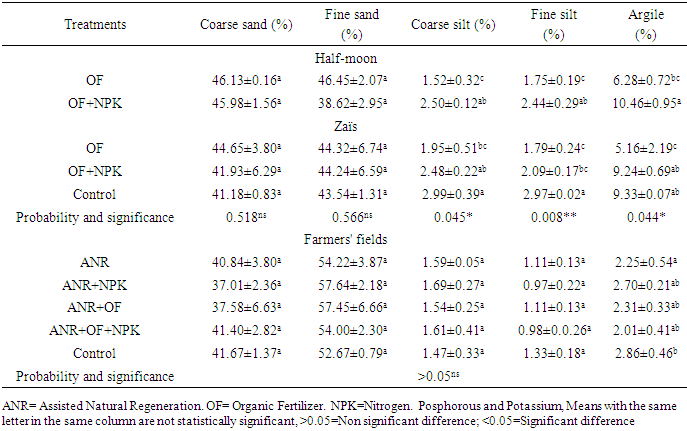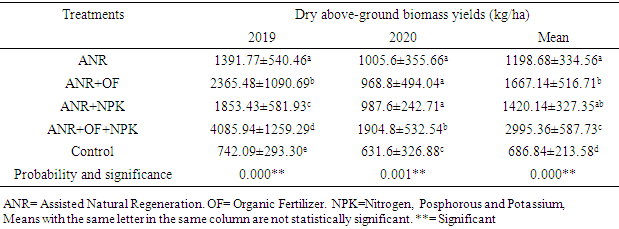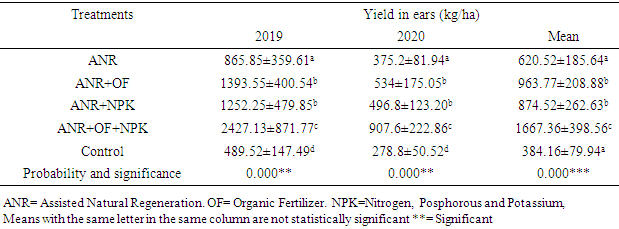-
Paper Information
- Paper Submission
-
Journal Information
- About This Journal
- Editorial Board
- Current Issue
- Archive
- Author Guidelines
- Contact Us
International Journal of Agriculture and Forestry
p-ISSN: 2165-882X e-ISSN: 2165-8846
2022; 12(2): 45-54
doi:10.5923/j.ijaf.20221202.02
Received: Jul. 20, 2022; Accepted: Aug. 19, 2022; Published: Sep. 15, 2022

Effect of Climate-Smart Agriculture Technologies and Practices on Soil Fertility and Millet Yield in Fakara, Niger
D. D. N. I. Abdoul Aziz, Larwanou M.
Department of Rural Engineering and Water and Forestry, Faculty of Agronomy, Abdou Moumouni University of Niamey, Niger, Niamey-Niger
Correspondence to: D. D. N. I. Abdoul Aziz, Department of Rural Engineering and Water and Forestry, Faculty of Agronomy, Abdou Moumouni University of Niamey, Niger, Niamey-Niger.
| Email: |  |
Copyright © 2022 The Author(s). Published by Scientific & Academic Publishing.
This work is licensed under the Creative Commons Attribution International License (CC BY).
http://creativecommons.org/licenses/by/4.0/

In Fakara, soils have shown their limitations in supporting crop development, and promising climate-smart agriculture technologies and practices are poorly adopted. The present study aims to investigate the effects of these technologies and practices on soil fertility and millet yield. Randomized complete block designs with three replications and Fisher block designs were set up in half-moons and zaïs, and in farmers' fields, respectively. Soil samples were taken from a depth of 0-20 cm for analysis of soil physicochemical parameters. In terms of yield components and physicochemical characteristics of the soils, the treatments showed significant differences (P<0.05) in pH water, potassium, and proportions of coarse silt, fine silt and clay. Fertilizer inputs (organic and mineral) had significant effects (P<0.05) on yields of dry above-ground biomass, cobs and grains of millet, with the highest results recorded by the combination of organic amendment and mineral fertilizer with respectively 3540.4±1426.19 kg/ha; 1215.2±311.55 kg/ha and 692.22±223.51 kg/ha in the half-moons in the second, and in the farmer's field which are respectively 4085.94±1259.29 kg/ha; 2427.13±871.77 kg/ha and 1558.49±718.28 kg/ha in the first year (2019). And that in general, organic manure application combined with mineral fertilization in both types of structures was more effective than organic amendment alone and the control. Both the organic amendment and mineral fertilization provided satisfactory millet yields compared to the control plots. These technologies and practices can be recommended for reclaimed land with low fertility.
Keywords: Technologies and practices, Fertility, Half-moons, Zaïs, Millet, Kampa Zarma, Fakara
Cite this paper: D. D. N. I. Abdoul Aziz, Larwanou M., Effect of Climate-Smart Agriculture Technologies and Practices on Soil Fertility and Millet Yield in Fakara, Niger, International Journal of Agriculture and Forestry, Vol. 12 No. 2, 2022, pp. 45-54. doi: 10.5923/j.ijaf.20221202.02.
Article Outline
1. Introduction
- Millet is a staple food crop in arid and semi-arid regions of Africa and Asia (Shelke and Chavan, 2010). In Africa, the crop covers more than 21 million hectares, where nearly 500 million people depend on it for their survival. Africa accounts for 40% of the world's millet production (Saidou, 2011). In Australia and the United States, millet is the highly valued forage crop (Hamadou et al., 2017).Millet is the main crop in Niger, on two-thirds of the arable land area (Alzouma, 1990; Soumana, 2001; Soler, 2008), on more than 65% of the sown area (Abasse et al., 2013b; Kadri et al., 2019) and constitutes 75% of the country's total cereal production (INS, 2016; Aboubacar, 2019). It ensures food security (Saïdou, 2011) with about ten meals from grain processing among 85% of the population (Soumana, 2001). However, this crop faces enormous difficulties related to climatic hazards (spatio-temporal irregularity of rainfall) and soil poverty (Soumana, 2001; Zakari et al., 2016). This will further compromise the food self-sufficiency of the farming world (Yahaya, 2009). The degradation of natural resources remains today a major problem for the agro-sylvo-pastoral development of arid and semi-arid zones in West Africa (Pontanier et al., 1995). In these areas, the very precarious climatic conditions, the demographic explosion and the increased poverty of the soils no longer allow the maintenance of the balance between the exploitation of natural resources by man and their regeneration in time and space (Morin, 1993; Aronson et al., 1993).Recent studies (Barret et al., 2015; Vanlauwe et al., 2015) have shown that low soil fertility keeps people in chronic poverty. Mineral fertilizers are known to have immediate and beneficial effects on yields (Lamine, 2002). Nitrogen is the number one factor in yield among nutrients (Chaibou, 2013 and Hamidou, 2014). It is more expensive than phosphorus in fertilization and its management is very delicate. However, the majority of producers do not have access to it (Bagayoko et al., 2011) due to high prices, difficulties in accessing credit and the lack of appropriate technologies for applying mineral fertilizers, resulting in a low rate of mineral fertilization (10 kg/ha in sub-Saharan Africa) and technology adoption (FAO, 2013). In Niger, this rate is about 4 kg ha-1 (Hamidou et al., 2014). Investments in simple water harvesting techniques in the mid-1980s, such as improved traditional planting pans (zaï) and half-moons restored land productivity and recharged groundwater levels. Hundreds of thousands of Niger farmers, for example, have protected and managed naturally regenerating woody species on their farmland on more than five million hectares, making it the largest restorative transformation in Africa (Adam et al.,2021). In Fakara, soils suffer from water and nutrient losses due to runoff and crusting (Bationo et al., 2000).To cope with this situation, farmers have adopted a number of strategies including, conventional water and soil conservation techniques, soil defense and restoration, crop rotation, cereal-legume association and use of agroforestry species in the fields (Larwanou et al., 2006; Bationo et al., 2012).Technologies and practices such as land restoration (half-moons and zaïs), micro-dosing of organic and mineral fertilizers can be tested to boost soil fertility and optimize millet yields. This is the purpose of this study, which aims to evaluate the effects of climate-smart agriculture technologies and practices on millet fertility and yield on a highly unproductive soil.
2. Material and methods
2.1. Study Site
- The present study was conducted in the Fakara of Niger, rural commune of Dantchandou, department of Kollo, more precisely in Kampa Zarma. The latter is located between latitude 13°26'37.32'' North and longitude 2°38'58.56'' East, with a population of 1600 inhabitants (source: survey data in 2019). Agriculture and livestock are the main subsistence activities of the population. The climate is Sahelian, characterized by a long dry season of 8 to 9 months, from October to June, and a wet season of 3 to 4 months, from June to September.
2.2. Plant Material
- The plant material used in this work is the millet variety (Pennisetum glucum) ICMV IS 99001, with an average duration of 85 days in areas where rainfall is between 350 and 700 mm. The average height of the plants at maturity is 250 cm with a low tillering ability, long cobs and a grain yield of 1.5 t/ha.
2.3. Experimental Design
- The trials were installed in the half-moons and zaïs made on the degraded plateau in three (3) blocks or repetitions each, in the form of split-plot design, and in farmers' fields according to a Fisher arrangement, with fifteen (15) producers adopting the Assisted Natural Regeneration (ANR) technique. In each replication, plots of 300 m2 (20 m x 15 m) were established.
2.4. Physicochemical Analysis of Soil Samples
- Soil samples were taken with an auger at plot level and to a depth of 0-20 cm. These samples underwent some prelimiANRy preparations that consisted first of drying at room temperature in the laboratory. Once dried and crushed, each sample was sieved through a 2 mm mesh sieve to obtain fine soil that was subjected to chemical (pH water, organic matter, Bray phosphorus, exchangeable bases (Ca++, Mg+, Na and K+)) and physical (five (5) fraction granulometry) analyses.
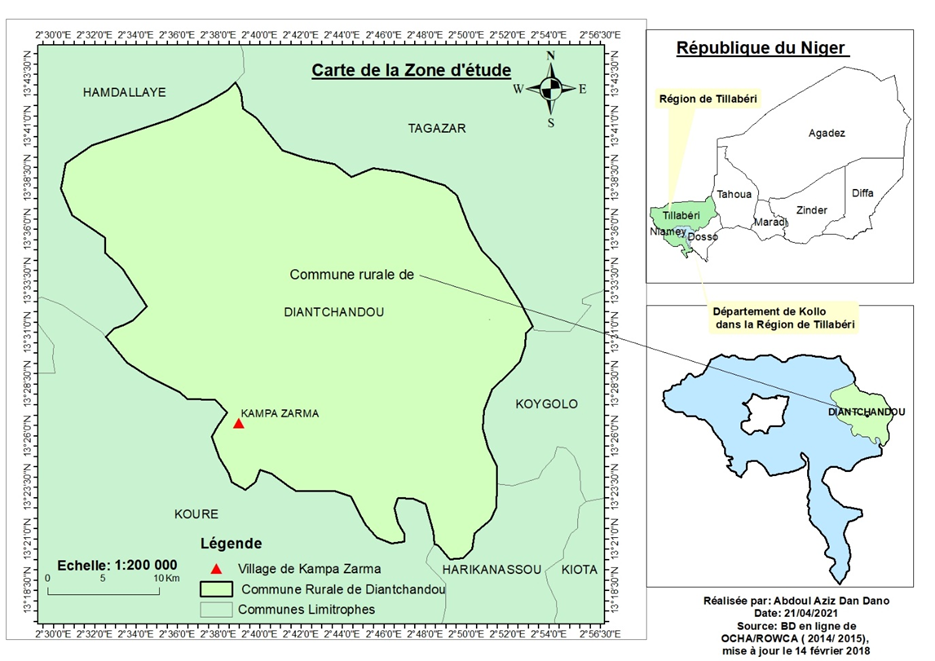 | Figure 1. Location map of the study site |
2.5. Trials Set up
- After the half-moons and zaïs were made, an amount of 100 g/pack of small ruminant manure was applied as a bottom dressing. In the first year, sowing was done from 02 to 03 July in 2019, and from 15 to 16 June 2020 for the second year. In the farmer's fields, sowing was done on June 15 of both years of experimentation. Weeding at four plants/bunch was done at the beginning of tillering, followed by the application of 6 g/bunch of microdose NPK (FAO, 2012) at the end of tillering.Three weedings were conducted at 40 days after sowing (DAS), 55 DAS and 75 DAS and two weedings at will in the farmers' fields.
2.6. Agronomic Parameters Measured
- Yield component measurements included number of bunches per hectare, cobs weight, seed weight and dry above-ground biomass weight were determined at full cobs maturity (95 DAS). The number of clusters per hectare was assessed by systematically counting the total number of clusters in the 300 m2 experimental plot at maturity. Dry above-ground biomass, spike and seed yields were obtained in 25 m2 yield squares in the zaï and farmer field plots, and in a randomly selected half-moon. These samples were collected on the basis of plot size and extrapolated to the hectare. To determine the effectiveness of the fertilizers relative to the absolute control, the following formula was used:E (%) = (RdtF-RdtT)/RdtF x 100E = manure efficiency; RdtF = manure yield; RdtT = control yield.
2.7. Data Processing and Analysis
- Millet yield data were entered into Excel 2010 to form a mask. This database was coded into qualitative and quantitative variables using SPSS version 23 software to calculate average millet yields according to treatments. The Clobal Linear Model (GLM) and analysis of variance (ANOVA) tests at the 5% threshold were applied respectively for the results in community fields and in farmers' fields to determine the significant differences between the treatments on the growth and yield of millet.The data on the physicochemical characteristics of the soil samples were subjected to the normality test with the R software version 4.0.2, followed by ANOVA tests for data that follow a normal distribution and Kruskal-Wallis for data that do not follow the normal distribution.
3. Results
3.1. Analysis of Physico-Chemical Parameters of Soil Samples Structures in Farmers' Fields
- The results of the ANOVA test of the physico-chemical parameters of the soil samples show that the treatments significantly affected the pH water and potassium contents in the half-moons and zaïs (Table 1). In the farmer's field, only the potassium content showed significant differences between treatments.
 | Table 1. Chemical characteristics of soil samples according to treatments |
3.2. Effect on Millet Yields in Farming Areas
3.2.1. Dry Above-Ground Biomass Yield of Millet
- Dry above-ground biomass yield of millet was determined as a function of treatments. Micro dose of organo-mineral fertilizers significantly affected millet dry aboveground biomass (p<0.05) in both years. In the first year. the highest dry above-ground biomass yield of millet was obtained with the ANR+OF+NPK treatment (4085.94±1259.29 kg/ha). followed by the ANR+OF treatment (2365.48±1090.69 kg/ha). then the ANR+NPK treatment (1853.43±581.93 kg/ha) and then the ANR treatment (1391.77±540.46 kg/ha). The control treatment gave the lowest dry aboveground biomass value (742.09±293.30 kg/ha).In 2020 the ANR+OF+NPK treatment (1904.8±532.54 kg/ha) recorded the highest aboveground biomass yield. followed by the ANR treatment (1005.6±355.66 kg/ha). then the ANR+NPK treatment (987.6±242.71 kg/ha) and the ANR+OF treatment (968.8±494.04 kg/ha). Finally. the dry aboveground biomass yield was obtained for the control treatment (631.6±326.88 kg/ha).The dry aboveground biomass yield obtained in 2020 for the ANR treatment is higher than that obtained with the ANR+OF and ANR+NPK treatments in the same year. In 2019. the ANR+OF treatment in 2019 yielded the higher dry aboveground biomass value than that obtained for the ANR+OF+NPK treatment in 2020.
|
|
3.2.2. Millet Cobs Yield
- The results of ANOVA test at 5% threshold. showed that treatments had significant effects (p<0.05) on cobs yield in both years of experiment (Table 4).
|
3.2.3. Grain Yield of Millet
- The results of ANOVA of millet grain yield according to treatments. showed statistically significant difference (P<0.05). The highest millet grain yield is obtained in the first year (2019) for ANR+OF+NPK treatment (1558.49±718.28 kg/ha). followed by ANR+OF treatment (832.59±376.56 kg/ha). then ANR+NPK (782.52±394.39 kg/ha). and finally by the control treatment (284.76±109.31 kg/ha) (Table 5).
|
3.3. Effects on Millet Yields in Half-Moons and Zaïs
3.3.1. Dry Above-Ground Biomass Yield
- The results of the GLM test show that the structures did not have significant effects on the weight of dry above-ground biomass of millet. On the other hand. organic and mineral fertilizers significantly influenced the dry above-ground biomass yield of millet in both years of the experiment (p<0.05) (Table 6).
|
3.3.2. Yield in Cobs of Millet
- Millet cobs yields as a function of structures and treatments are recorded in Table 7. The analysis of the results of the GLM test shows that the treatments had significant effects on the weight of the ears (p<0.05). However. the structures did not significantly affect this parameter (p>0.05).
|
3.3.3. Grain Yields
- Treatments significantly influenced millet grain yield (p<0.05). In contrast. half-moons and zaïs did not have significant effects on this yield component (Table 8). In 2019. the highest millet grain weight in half-moons was recorded for the OF treatment (98.36±32.89 kg/ha) followed by the OF+NPK treatment (82.98±47.71 kg/ha). While in zaïs. the highest average millet grain weight obtained for the OF+NPK treatment is 96.53±47.11 kg/ha. followed by the +OF treatment (90.86±63.42 kg/ha). The control treatments in zaïs and half-moons gave the lowest grain weights. with values of 19.46±12.93 kg/ha and 21.25±11.79 kg/ha respectively. The values of this same parameter obtained in the second year in the half-moons showed that the OF+NPK treatment (692.22±223.51 kg/ha) had higher results than those obtained for the OF treatment (306±139.39 kg/ha) and the control treatment (154±62.72 kg/ha). However. in zaïs. the combination of organo-mineral fertilization gave an average grain weight of 561.06±279.07 kg/ha. followed by the OF treatment (350.66±117.86 kg/ha) and finally the control treatment (117.33±62.82 kg/ha) which recorded the lowest grain yield.The performance in ear weight is obtained with the OF+NPK treatment in the half-moons. and the control plots in 2020 recorded the highest results for this parameter compared to the combination of organic and mineral manures and organic amendment in 2019.
3.4. Relationship between Grain Yields. Dry Aboveground Biomass and Soil Physicochemical Parameters
- The relationships of the results between the yields of dry above-ground biomass. grains. and the physicochemical characteristics of the soil were translated into a Principal Component Analysis (PCA). In the farmer's field (b). axis 1 accounted for more than 50% of the variance and the two axes accounted for more than 75% of the variance in the structures (a). Dry above-ground biomass and grain yields are more favored by the presence of chemical elements such as phosphorus. organic carbon and sodium in the farmer's field. In the structures. the production of dry above-ground biomass and grain of millet is better favored by the presence of magnesium. sodium and organic carbon.
|
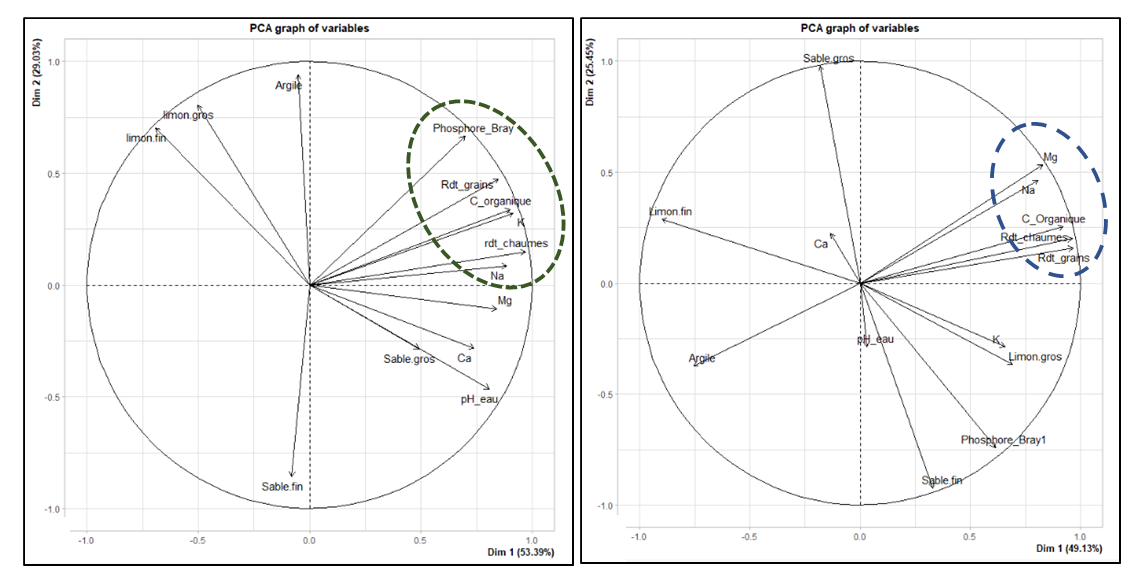 | Figure 2. Relationships between grain and dry above-ground biomass yields and physicochemical parameters of soil samples in the farmer's field (A) and in structures (B) |
4. Discussion
- The higher pH and potassium levels observed in the plots may be due to the organic and mineral amendments applied. These results showed that for the inputs made. the pH content is close to that obtained by Zoumon (2021) which is 5.88; while for the potassium content is 0.10 meq/100g in the three agroecological zones of south-central Niger. For soil particle size fractions. the results showed no significant difference in farmers' fields. The same observations were made by Dan Lamso (2015) under Guiera senegalensis clumps according to distance for the granulometric fractions and in addition depth for the pH which remains acidic. This analysis was confirmed by the work of Yahaya (2017) in the peripheral areas of Park W.Treatments in the ANR fields boosted millet yields considerably. This shows that ANR plays an important role in increasing millet production through soil fertility improvement. This analysis confirms the work of Larwanou et al (2006) who showed the contribution of trees in improving soil fertility. The best yields are recorded for the combination of organic and mineral fertilization. The results obtained for both years are higher than those found by Zoumon (2021) for dry aboveground biomass. ear and grain yields in all zones combined in south-central Niger. This difference may be related to the dose of fertilizer applied. and the nature of the organic manure used. which is essentially cow dung in the present study. For grain yield. the results of the different treatments in 2020 are lower than those found by Ndiaye et al. (2017) with the application of 5 tons/ha of manure and the combination of NPK and Urea. This difference is due to the amount of manure applied by the latter. which is 500 g/pack. or 5 times the applied rate.The highest average weights of dry above-ground biomass. cobs. and millet grains in the two years of the experiment were obtained in the half-moon and zais plots that received the organo-mineral fertilizer. The average dry aboveground biomass yields obtained in the half-moons with the two types of treatments OF+NPK and OF are higher than those found in the zaïs with the same treatments. These results obtained in the zaïs are not in phase with those of Philippe et al. (2011) who found average dry aboveground biomass yields of 947 kg/ha and 509 kg/ha respectively by the OF+NPK combination and without any fertilizer application in the zaïs. and those found by Somé et al. (2004) who obtained 795 kg/ha at the zaïs level with manure application. Organic and mineral amendments did not give satisfactory results on average grain weight. This may be related to the ridged nature of the soil on which the trials were conducted. Philipe et al (2011) obtained grain yields of 383.10 kg/ha from zaï alone and 487 kg/ha from the treatment with OF. These data obtained are higher than those of the present study and this may be due to the agro-ecological conditions of the study areas or the types of varieties used. and the pockets of drought observed at the vegetative phase and at maturity and according to Kabore et al.. (2019). the early cessation of rainfall is the greatest risk that causes the decline in millet yields. Zaïs techniques are less laborious and offer satisfactory results compared to half-moons. According to Izza (2017). producers tend to prefer zaï techniques over half-moons because of the intensity of effort required to carry them out. Manure and fertilizer applications in the second year in half-moons and zaïs yielded very satisfactory average grain weights. with 692.22±223.51 kg/ha and 561.06±279.07 kg/ha respectively. These results are superior to those of François and Souleymane (2006) who obtained average millet grain yields of 521 kg/ha at the zaï level and 614 kg/ha at the half-moon in the manure + urea + NPK combination compared to 438 kg/ha at the zaï level. and 504 kg/ha at the half-moon with manure. Bilgo (2012) obtained higher average grain yields of 1035 kg/ha for the OF+NPK treatment and 381 kg/ha for the OF treatment in zai. Mineral and organic manures applied in micro-doses showed an efficiency of increasing millet yields by 123.22% to 462% in these works compared to the control. Indeed. Bado (2012); Muehli et al. (2003) showed that the performance of the micro-dose would be explained by the fact that the fertilizers applied are located in the superficial horizon colonized by the roots of plants. which generates their proliferation and growth and allows plants to better capture nutrients and water. Also. studies have shown that the application of manure improves cereal yields (Bationo and Ntaré. 2000; Kiba. 2012). These same authors emphasized that manure application plays a very important role on nutrient recycling. soil fertility and improvement of crop production. In addition to organic manure. treatments that received micro-dose NPK had the highest yields in ears. grains and dry aboveground biomass. Thus. Kaboré (1995) concluded that the insufficiency or absence of NPK elements in the soil leads to yield reductions. Ouattara (2007) showed that most soils with natural poverty react positively to different fertility improvement practices.
5. Conclusions
- The present study conducted in Fakara determined the effect of climate-smart agriculture technologies and practices on millet maturity and yields. The results of the standardized rainfall index analysis showed that the two winter periods of 2019 and 2020 were marked by significant variability. and that the months of June and October. which coincide with the vegetative phase and maturity of millet respectively. were dry. It was recorded that organic amendments and mineral fertilization had significant effects on pH water content. potassium content. grain size proportions of coarse silt. fine silt and clays. and on millet yields.
ACKNOWLEDGEMENTS
- At the end of this study. we would like to thank the CGIAR program on Climate Change and Food Security for funding all research activities. and ICRISAT for hosting and accompanying the work.
 Abstract
Abstract Reference
Reference Full-Text PDF
Full-Text PDF Full-text HTML
Full-text HTML